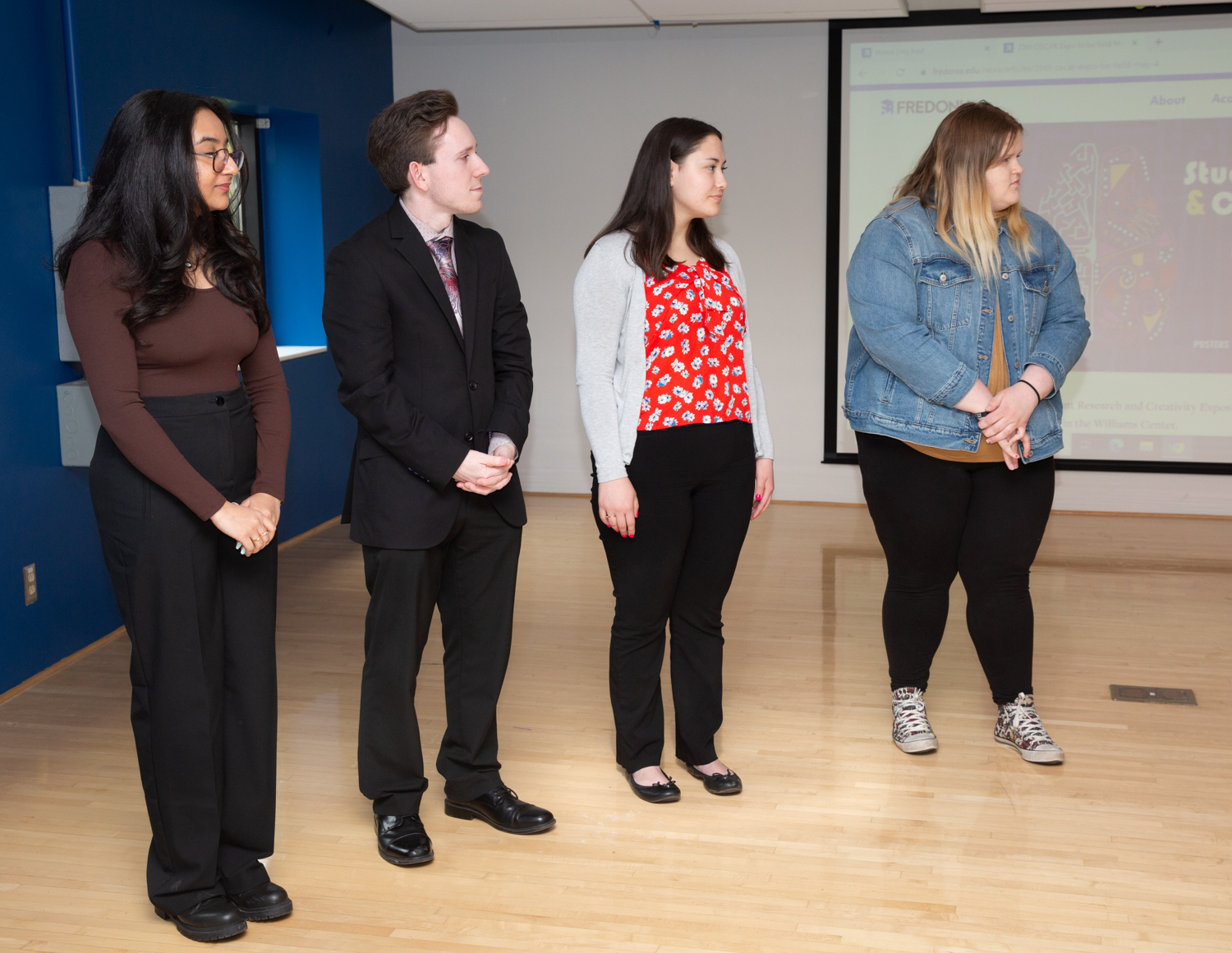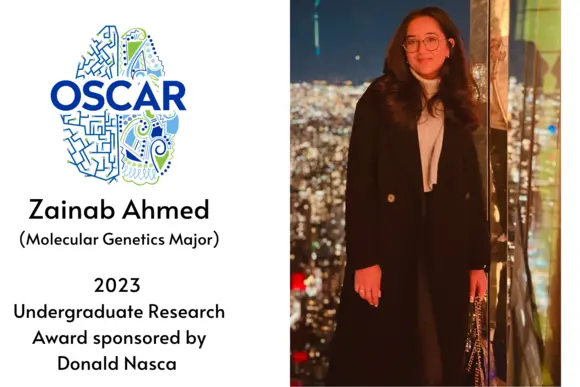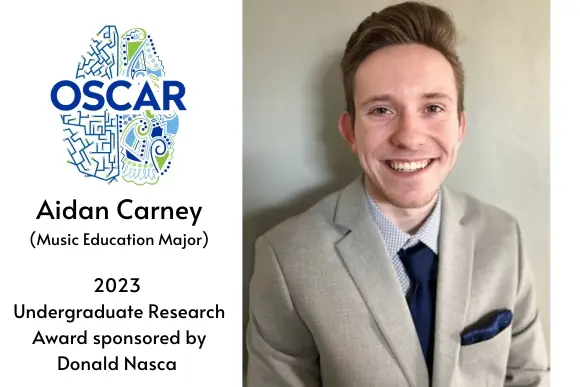Nasca Award Winners 2023
Undergraduate Research Award Sponsored by Donald Nasca
The four 2023 Undergraduate Research Award winners were announced on May 4 at the 2023 OSCAR Expo. The students who earned the award were celebrated by family and friends.

The photo above is of awardees at the 2023 OSCAR Expo: Zainab Ahmed, Aidan Carney, Amanda Roth, and Savannah Steves. Continue reading to learn more about each student's project.
Recruitment and retention strategies used by instrumental music educators vary widely from district to district. This in-progress research study aims to explore teachers' use of a researcher- created app during the instrument selection process for beginning instrumental students. Research questions that guide this study are (a) how do they describe their experiences using the app for the selection process? and (b) what are their perceptions of the effectiveness of the app? Data will include interviews with practicing teachers in Chautauqua County who use a researcher-created app to support the instrument selection process.
Aidan has worked with Dr. Jill Reese and Mr. Greg Cole to create a basic version of an instrument selection app. The app will feature pictures of instrumentalists for each instrument that represent the diversity of gender and race. Researchers suggest that gender stereotypes (Cannava, 1994; Dangler, 2014; Tarnowski, 1993) and ethnicity (Fomby, 2020; Johnson & Stuart, 2004) influence instrument choice and assignment. He will also work with composers at SUNY Fredonia to create an original melody highlighting the instruments' upper, middle, and lower ranges. He'll work with sound recording experts and studio professors at SUNY Fredonia to record audio that provides a professional model for the recordings. Once the app is completed, he will contact instrumental music teachers in Chautauqua county, provide them with the technology and the app to use during the instrument selection process for beginning instrumental students. Once the teachers have finished using the app with their students, Aidan will conduct a qualitative interview of the teacher’s initial perceptions of the app and their perceived impact of its use on student recruitment and instrument selection. When he will have finished collecting all of the data, he will analyze the qualitative data throughout March and April. He intends to apply to share my findings at the OSCAR Expo in May 2024.
Access to clean water is a challenge in poorer countries with large rural populations and pose great health risks. In Honduras there are an estimated 7.5 million people without access to safe drinking water. Instead of water, many resort to sugary drinks or other alternatives that negatively impact their health. For those living with underlying health issues, especially children, clean drinking water is essential for life. The lack of access to safe water is the leading cause of death for children under the age of five in these developing countries which is why this access is so crucial.
The aim of this research is to identify bacteria found in the drinking water from Honduran homes in rural villages. Many homes do not have filters nor access to clean water. Homes in some villages received filters from Filters of Hope pre-pandemic, however bacteria have been found
within the collected water samples from these filters over the past year (T. Lee, personal
communication). The presence of bacteria indicates that the filters are not working as they should be. The bacteria present in the filtered samples pose potential negative health effects to those living in these rural villages.
In Honduras, it is common for those living in these rural areas to collect their water in pilas, devices similar to wells that are used for drinking water or other activities like cooking. This water is provided by the government and it is pumped to the homes. During the January (2023) Fredonia J-term Program, I participated in the initial analysis of water collected in pilas used for drinking and cooking activities in the homes of these rural areas. Samples were taken from selected houses in each of the villages, and brought back for testing. The tests consisted of determining pH levels and growing bacteria on media to identify bacteria species by genetic testing. When the filters are not backwashed or cleaned on a regular basis they do not filter properly, which is a common issue for those with filters in Honduras. Escherichia coli and other bacteria were filtered through both filters, and the filtrate was plated on media. Over time as shown in Honduras the filters decrease in effectiveness.
Amanda will travel to Honduras in August 2023 to collect water samples to bring these and used filters to Fredonia for testing. The bacteria from the pre-filtered and post-filtered drinking water samples will be isolated and characterized. To identify bacteria in the drinking water samples, the colonies will be isolated individually using aseptic technique and independent culture study. The bacteria will be grown on nutrient agar and colonies will be selected for isolation on another nutrient agar plate. Nutrient agar will be used because it is a general purpose medium and allows for the growth of many non-fastidious microorganisms. Using nutrient agar will allow many different species of bacteria in the water samples to grow for analysis and identification. Samples will also be plated on VRB-MUG. VRB-MUG is a differential and selective media for gram negative bacteria. MUG (4-methylumbelliferyl-β-D-glucuronide) is cleaved by an enzyme in E. coli that allows it to give off fluorescent light and is used to determine if E. coli is present in the drinking water. Current samples from January of 2023 will be compared to the water samples from the village homes in August of 2023 to assess the quality of filtration and drinking water. The microorganisms in the filtrate will be identified by amplifying the 16S rRNA gene and sequencing PCR products (3). This gene is present in all bacteria and is routinely used for identification of species in the environment, including water. The DNA will be isolated from the bacteria colonies plated on VRB-MUG and the DNA will be directly isolated from the drinking water samples for culture independent identification and comparison. The gene will be amplified by PCR and we will then sequence the PCR products. There are databases of 16S rRNA sequences that we will use to identify what species of bacteria are present in the water
Defects in centrosome integrity can be broadly classified into structural and numerical alterations, although structural alterations can lead up to numerical changes as well. These obstructions in centrosome function have been associated with the pathogenesis of human cancers, particularly of hormone regulated organs such as breasts, ovary and testis. Much research has focused on the direct causes of centrosome aberration, with less attention paid to the ultimate upstream factors that initiate many of the signaling pathways involved in centrosome-driven tumor progression. Recent studies have identified estrogen signaling as one of the major drivers of the manifestation of centrosome abnormalities. Estrogen signaling can be classified in genomic and non-genomic responses. Genomic responses are identified by changes in gene transcription. The first comprehension of estrogen and sex hormones connection to centrosome defects and genome abnormality in cancers of hormonally regulated tissues came from studies in rodent- prostate, breast and cervical cancer cells. The sex hormone and estrogen were reported to cause defects in bipolar mitotic spindle formation, centrosome supernumerary, and increased karyotype variabilities.
Synthetic estrogen, Bisphenol A (BPA) is the most common industrial plasticizer and is also reported to disturb centrosome duplication, karyotype stability and result in genomic instability. It also promotes migration, invasion, metastasis, proliferation and cell transformation in lungs, breasts and colon cancer cells. Another synthetic estrogen, DES, a drug used to prevent miscarriages and premature births has also shown to have put women at an increased risk for cancer and other diseases. Estrogens have also shown to interact directly with microtubules. The ability of estrogens to disrupt MTs has been shown in Chinese hamster cells.
Environmental estrogens alter the steps in the centrosome cycle thereby triggering defects in centrosome integrity. In the presence of estrogen, centrosomes over-duplicate or disengage prematurely before completing the chromosome segregation, forcing defects in the spindle organization and hence in the genome.
The goal of the project was to culture the human oral squamous cell carcinoma line UPCI:SCC10 and examine the effects of β-estradiol on centrosome duplication, mitotic outcomes and cell viability. First, we ran a Western blot on isolated proteins from our chosen cell line with antibodies to the Estrogen Receptor Beta to confirm the presence of an estrogen receptor in our cell line.After this, cells were treated varying concentrations of β-estradiol to determine viability. Subsequently, cells were treated with 10 μM of β-estradiol. We then used immunofluorescence to score for mitotic index and defects. Our results had supported our hypothesis of observing an increase in mitotic defects when exposed to estrogen, moreover, we specifically noticed an increase in multipolar spindles. From the results gathered, we designed a new experiment to confirm the increasing number of mitotic spindles. We planned to count the number of centrosomes in our cell line that was exposed to similar control and treated conditions. The results of this experiment supported our previous finding of increased centrosomes. However, while we report increases in centrosome number, the increases are slight. To that end, our future steps in the lab are to experiment with higher concentrations of β-estradiol. We are going to run viability assays on 50, 100, 150, 200, 250 μM of β-estradiol on our cell line UPCI:SCC103 to determine which concentration gives us the best result. The concentration determined will then be used to treat the cells and using immunofluorescence the cells will be scored for mitotic index and defects as we had done previously for 10μM of β-estradiol. We will also do increasing durations of exposure to the β-estradiol beyond the 72 hour exposure tested thus far. We have hypothesized that we will see an even greater increase in mitotic defects and especially the multipolar spindle. Consequently, we expect to observe an increase in centrosome number, tying the two phenomena together.
Throughout history, there have been several known paleo-droughts impacting parts of the world, including North America. The most significant of these is termed the 4.2 ka (4,200-year-old) event (Booth et al., 2005). Evidence suggests that this mega-drought was extensive, spreading across the Northern Hemisphere and lasting close to 100 years. The evidence for this event was first discovered in the early 1990s, when archaeologists, more specifically Harvey Weiss and colleagues at Yale University, were curious about what pushed the Akkadian Empire south from northeastern Syria (Voosen, 2018). Initial evidence suggested to Weiss that drought was to blame. Years later, Mike Walker, a geologist and paleoclimatologist at the University of Wales, picked up where Weiss’s work had left off and found further evidence of a substantial drought during this period in stalagmite records located in Mawmluh Cave, India. Since this early research, evidence of the 4200-year-old drought has emerged in other parts of Northern Hemisphere including Mesopotamia, the Americas, and Asia (e.g., Booth et al., 2005; Purtill et al., 2019). In these areas, drought conditions are believed to have impacted local cultures. The exact causes, and spatial extent, of this drought are still debated, but some research suggests that it is related to a weakened monsoon cycle (Voosen, 2018). The exact impact of the 4.2 ka event on various cultures worldwide are still being explored. How this mega-drought potentially impacted western New York remains unclear, but recent discoveries at a local archaeological site called the McKendry site may provide the first evidence that this drought did impact regional environments and Native American cultures.
The McKendry archaeological site is a precontact Native American archaeology site located near Irving, New York (Whalen & McKendry, 2011). Excavations of the site have been conducted since the 1980s. Evidence from the excavations suggest that there were several occupations in the area, with the most intensive sometime between 3000 and 400 B.C. This period is referred to as the Late Archaic and Early Woodland by archaeologists (Ritchie 1965). There is evidence that the Native Americans lived, at what is now the McKendry site, for short periods of time during which they cooked food, hunted, repaired tools and conducted other activities needed to survive. Archaeologists have established the age of occupation through radiocarbon dating, as well as the classification of thousands of recovered artifacts analyzed at the University of Buffalo. These artifacts include spear points, pottery, and a smoking pipe (Whalen & McKendry, 2011).
Recent geoarchaeology work at McKendry by Dr. Purtill, and several SUNY Fredonia students, have identified a sedimentary unit that appears to represent wind-blown ‘loess’. Loess, a word originating from the German word Lӧss, is typically deposited during periods of dryness, such as during a drought (National Geographic Education, n.d.). Loess accumulates in environments that are similar to that of a desert. Unlike other types of soil, loess tends to be pale colored and loosely packed. Particles are predominately silt-sized which allows them to easily be carried by the wind. Importantly, archaeological evidence indicates that Native Americans were living at McKendry during the period in which loess was being deposited. If Dr. Purtill’s hypothesis is correct that this loess reflects drought-like conditions, then Native Americans were living at McKendry during a period of extreme aridity.
Our hypothesis is that loess sedimentation reflects a local expression of the 4.2 ka event. If true, this means that Native Americans lived through a substantial episode of climate change. How they adapted, responded, and thrived during this climate change with far fewer advanced technologies, could provide valuable lessons to our current society dealing with our own episode(s) of climate change. However, the first step is to determine the age of the loess sediments to see if it aligns with the 4.2 ka event.
In order to test this hypothesis, Savannah proposes to submit two sediment samples from the McKendry site for Optically Stimulated Luminescence (OSL) dating at Baylor University’s Geoluminescence Dating Research Laboratory. OSL provides a measure of time since sediment, typically quartz or feldspar sand grains, were deposited and shielded from a light/heat source, most notably the sun (Baylor University, Department of Geosciences Website, n.d.). OSL has revolutionized the chronological dating of landforms created by blowing sand deposits, such as dunes or loess. Thus, OSL is the perfect method to determine the age of the loess sediments at McKendry. As outlined at the Baylor University, Department of Geosciences website (n.d.), OSL dating relies on the determination of the environmental dose rate which is an estimate of the exposure of mineral grains to ionizing radiation, primarily the decay of U and Th series elements, after burial. This ionizing radiation is the energy source by which electrons jump to higher energy shells where they can become trapped in lattice defects of individual grains. When eventually exposed to a high energy source under controlled lab conditions, entrapped electrons fall to lower shells and luminesce at a rate equal to their length of burial, thus providing a depositional age. The OSL technique can date layers more than 100,000 years in age, so it is suitable for use with sediments from the McKendry site.
The first of the two proposed OSL samples already have been collected by Dr. Purtill. The second proposed sample will be collected by Dr. Purtill and Savannah sometime in May-June. Since the laboratory analysis will take several months to complete, she will submit the OSL samples in early summer to assure that results arrive during the Fall (2023) semester. Once results arrive, her job will be to integrate results into the on-going geoarchaeological work conducted by Dr. Purtill and several of his students (including me). In consultation with Dr. Purtill, Savannah will review various literature sources on the 4.2 ka event (e.g., Booth et al., 2005) , local geological history, as well as local archaeology (e.g., Ritchie, 1965; Whalen & McKendry, 2011) to help interpret the OSL results and provide initial thoughts as to their archaeological significance. As part of this directed research, Savannah will prepare a report of the findings and present a poster at the annual OSCAR Student Research and Creativity Exposition.
Access the videos below to hear from students awarded the 2023 Undergraduate Research Award sponsored by Donald Nasca. In the videos, they describe their projects, the value of student-faculty collaboration for undergraduate students, and the value of the support from the Undergraduate Research Award sponsored by Donald Nasca.

Zainab Ahmed (Molecular Genetics Major)
Project Title: "Induction of Mitotic Defects via Estrogen-Linked Signaling"
Mentors: Nicholas Quintyne (Assistant Professor of Biology)
Video of Zainab Ahmed: Value of this experience and the support from the Nasca Award
Aidan Carney (Music Education Major)
Project Title: “Recruitment of Beginning Band Students: Teachers’ Experience and Use of Technology”
Mentors: Jill Reese (Professor of Music Education) and Greg Cole (Instructor of Computer Information Sciences)
Video of Aidan Carney: Value of this experience and the support from the Nasca Award
